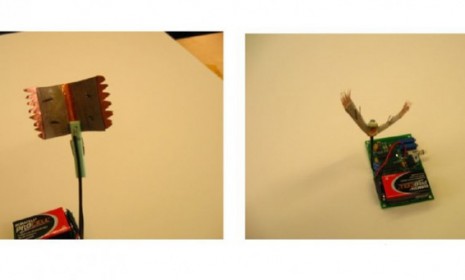The 'alarming' robotic Venus flytrap
An engineer from the University of Maine creates a mechanized version of everyone's favorite carnivore plant. How does it work?

Robots can already walk our dogs. Why not put them to work catching pesky houseflies, too? University of Maine engineer Mohsen Shahinpoor is trying to do just that, with a mechanical bug killer modeled after the Venus flytrap. How does his predatory plantbot work? Here, three key questions:
How do Venus flytraps catch bugs?
The plants, which derive energy from digested flies and spiders, employ mouth-like leaves covered in tiny hairs. If an insect touches two different hairs within 20 seconds, the trapping motion is triggered. The leaves slam shut like a clam shell and capture the bug in a mere 100 milliseconds. Then it's lunchtime.
The Week
Escape your echo chamber. Get the facts behind the news, plus analysis from multiple perspectives.

Sign up for The Week's Free Newsletters
From our morning news briefing to a weekly Good News Newsletter, get the best of The Week delivered directly to your inbox.
From our morning news briefing to a weekly Good News Newsletter, get the best of The Week delivered directly to your inbox.
And how does this new robotic version work?
Shahinpoor's prototype replaces the ultra-sensitive plant hairs with a special polymer membrane coated in gold electrodes. When a bug lands on one of the device's "leaves," the "tiny voltage it generates triggers a larger power source to apply opposite charges to the leaves, making them attract one another and closing the trap," explains New Scientist.
Will the future be full of killer, bug-eating robots?
Well, not quite. Shahinpoor's prototype "doesn't eat the bug," says Jack Loftus of Gizmodo. So the robot can't refuel itself — at least not yet. Regardless, a robot that can kill anything — even just a bug — is "alarming," says Rebecca Boyle at Popular Science. This model is "a major step on the path towards robots that can hunt, catch and digest their own meals."
A free daily email with the biggest news stories of the day – and the best features from TheWeek.com
Sources: Gizmodo, New Scientist, Popular Science
-
 Pakistan: Trump’s ‘favourite field marshal’ takes charge
Pakistan: Trump’s ‘favourite field marshal’ takes chargeIn the Spotlight Asim Munir’s control over all three branches of Pakistan’s military gives him ‘sweeping powers’ – and almost unlimited freedom to use them
-
 Codeword: December 6, 2025
Codeword: December 6, 2025The daily codeword puzzle from The Week
-
 Sudoku hard: December 6, 2025
Sudoku hard: December 6, 2025The daily hard sudoku puzzle from The Week